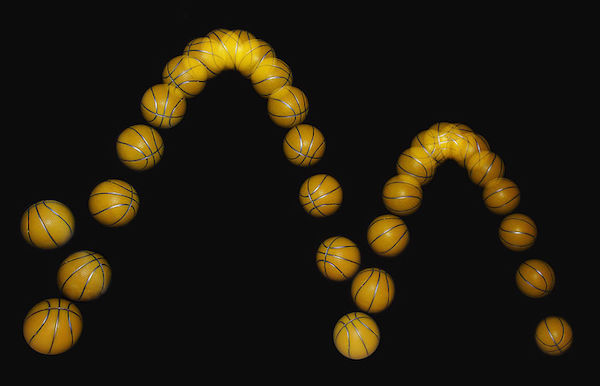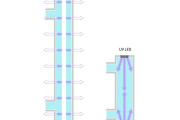In this series, we discuss short-term challenges for the LED industry – avoiding obvious discussion points like cost and focusing instead on more subtle but equally important considerations.
|

|
|
A bouncing ball captured with a stroboscopic flash at 25 images per second. (Image by Michael Maggs edit by Richard Bartz)
|
The last Soraa blog post discussed various consequences of driving LEDs, an inherently DC component, with alternative current. Today,Soraa Chief Scientist Aurelien David takes a closer look at one of the most infamous of these: flicker. Flicker is a hot-button topic these days, and one where LEDs tend to struggle.
First, let’s clarify that flicker covers a variety of phenomena. There is direct flicker, which can be perceived by simply observing the light source; direct flicker is highly dependent on the frequency of the flicker, with humans having a peak sensitivity at a few Hz and nearly no sensitivity above 60Hz.
However, indirect flicker can still be perceived at higher frequency, with a variety of manifestations. The most common, called stroboscopic flicker, is a perception of visual jaggedness caused by moving objects or by a rapid eye movement. Stroboscopic flicker is a somewhat common experience for LED users, and depending on the viewing context, it can be barely noticeable or unacceptable – good luck catching that basketball under the wrong light! Research shows that stroboscopic flicker can be triggered at frequencies above 1000Hz, well beyond the threshold of conscious perception. In addition, indirect flicker can also have physiological implications like lower employee performance, triggering headaches and epileptic seizures in photosensitive people. As someone who gets a migraine from the flicker caused by the stripes of that one crosswalk during David's routine jogging…
Research to understand flicker perception is ongoing. It is clear that the actual waveform of light (shape, amplitude variations, frequency…) plays a central role; in addition, external factors including the visual environment (location of the light source, surrounding illumination…) also have some influence, as does individual sensitivity.
Unfortunately, due to this complexity, few metrics are available to describe these various aspects of flicker. The two most common, percent flicker and flicker index, are simple but seen as flawed: for instance, they ignore frequency which is central to the perception of direct flicker. More advanced metrics are currently being researched by a variety of entities, including the CIE, the IES, the IEEE… Today, in the absence of a recognized metric, the best approach is experimental: a simple visual test with a flicker wheel or a wagging finger often provides an unambiguous answer. For instance, the California Energy Commission indicates in its Voluntary Quality Spec that “flicker testing should be conducted by observers who are flicker sensitive”.
LEDs struggle with flicker, in part because their fast response time means that they follow the electrical waveform they are fed. LED drivers try to rectify AC waveforms to as smooth an input as possible, but this can be a complex task – especially when dimmers enter the equation, as the driver must be compatible with the variety of waveforms fed by different dimmers; this makes flicker issues more pronounced in dimmed situations.
So in practice, how can flicker be reduced in LEDs? Of course, the easy way out is to get rid of AC current and use a constant-current installation, but this is not always an option. In retrofit applications, the basic answer is to design better drivers, which can always be done with the right capacitors. The difficulty, of course, lies in the tradeoff between flicker and other crucial aspects: cost, size, and heat. Capacitors with better energy storage tend to cost more, take space and sustain less heat – none of which sounds good when the driver has to be crammed in the base of a tiny retrofit lamp!
Thus, manufacturers are faced with tricky alternatives. Should the A-bulb sold at home improvement stores be flicker-free, or rather a dollar cheaper to sneak below a psychological price threshold? Should Soraa’s MR16 privilege very high candelas, or cut down on the power and heat to include a lower-flicker driver?
Fortunately, as often, this tradeoff is becoming less relevant as technology improves. In Soraa’s case, continuing progress in basic LED technology has enabled our new generation of lamps to generate as much light with a lower power input and less waste heat. We strive for simply perfect products which is why we were elated to present a true flicker-free solution at Lightfair earlier this month: our new MR16s available later this year, thanks to its improved driver, show less oscillation than a halogen lamp, no matter what the dimming conditions!
Looking ahead, we can only hope that such solutions become mainstream, so that we can finally stop worrying about flicker once and for all.





 CN
TW
EN
CN
TW
EN






